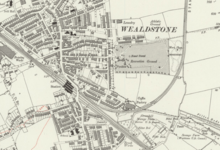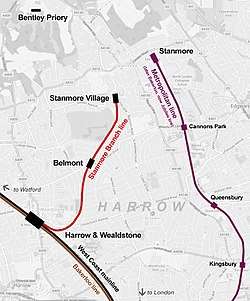Stanmore branch line
| Stanmore branch line | |||
|---|---|---|---|
|
The former Stanmore branch line platform at Harrow & Wealdstone | |||
| Overview | |||
| Type | Local rail | ||
| System | National Rail | ||
| Status | Dismantled, re-purposed as cycle track | ||
| Locale | Harrow, London, England, UK | ||
| Coordinates | 51°36′06″N 0°19′08″W / 51.60169°N 0.31876°WCoordinates: 51°36′06″N 0°19′08″W / 51.60169°N 0.31876°W | ||
| Termini |
Harrow & Wealdstone Stanmore Village | ||
| Stations | 3 | ||
| Operation | |||
| Opened | 1890 | ||
| Closed | 1964 | ||
| Owner | Fredrick Gordon (until 1899) | ||
| Operator(s) |
LNWR (1890-1922) LMS (1923-1948) British Railways (1948-1964) | ||
| Rolling stock |
LMS Fowler 2-6-2T British Rail Class 103 British Rail railbuses | ||
| Technical | |||
| Line length | 2.12 miles (3.41 km) | ||
| Track gauge | 1,435 mm (4 ft 8 1⁄2 in) | ||
| |||
| Stanmore branch line | ||||||||||||||||||||||||||||||||||||||||||||||||||||||||
|---|---|---|---|---|---|---|---|---|---|---|---|---|---|---|---|---|---|---|---|---|---|---|---|---|---|---|---|---|---|---|---|---|---|---|---|---|---|---|---|---|---|---|---|---|---|---|---|---|---|---|---|---|---|---|---|---|
| ||||||||||||||||||||||||||||||||||||||||||||||||||||||||
The Stanmore branch line was a railway line in Harrow, Middlesex (now Greater London), in the United Kingdom. Located to the north of London, it provided commuter rail services between Harrow and the village of Stanmore. Beginning at Harrow station (now called Harrow & Wealdstone), the line split off from the West Coast Main Line and followed a short 2.12-mile (3.41 km) route to Stanmore. The branch had two stations on the line, Stanmore Village and Belmont (opened later). It was built and promoted by the Harrow and Stanmore Railway, a company owned by local hotel owner Frederick Gordon, and operated by the London and North Western Railway company (LNWR).
The line was closed in 1964 during the Beeching axe and today the route only exists as a rail trail footpath and cycle route. The empty platform for the branch line is still visible today at Harrow & Wealdstone station.
History
Construction
In 1882 the entrepreneur and hotelier Frederick Gordon purchased Bentley Priory, a large country house near the rural village of Stanmore. He planned to open it up as a country retreat for wealthy guests. Known as "The Napoleon of the Hotel World", Gordon was a successful international businessman, and had earned his millions through companies such as Ashanti Goldfields, Apollinaris and Johannis, Pears soap and Bovril. The location of Bentley Priory suffered from a lack of transport connections, and Gordon was not content to ferry his paying guests by horse-drawn stagecoach from London. In order to make his resort more appealing to affluent clientele, he proposed the construction of a short railway line from nearby Harrow. Gordon struggled to raise the necessary capital to build the line, and funded most of its construction himself. He successfully negotiated a contract with the LNWR, the railway company that owned the mainline at Harrow, to operate the Stanmore line on his behalf.[1]
Gordon's scheme met with some local opposition and he was forced to re-route the railway line further east to mitigate objections. The site for a terminus was selected in Old Church Lane in Stanmore. To allay the concerns of the local inhabitants — and to appeal to his well-heeled customers — Gordon commissioned an architect to design an elegant station building that resembled a Gothic-style English country church. After receiving parliamentary approval, Gordon began building work in July 1889.[1]
The Stanmore branch line opened to great fanfare on 18 December 1890, turning Harrow into a junction station.[2] The line terminated at Harrow in a bay platform on the north side of the station, adjacent to the London-bound platforms. From the outset, the line was staffed and operated by the LNWR, and after the first year the LNWR took over maintenance and repair of the line as well. Initially, train service patterns between Harrow and Stanmore were arranged to suit an upper-class leisure market; trains began running mid-morning and would end in the early evening, making the service unsuitable for ordinary workers.[3]
Meanwhile, Gordon's business ambitions expanded; in Stanmore village he purchased land near the station and laid out a wide avenue — named Gordon Avenue — lined with new superior houses, in the hope of attracting wealthy Londoners to come to live in the country and commute into the city on his new railway. Despite the enormity of his efforts, Gordon's Stanmore ventures were not particularly successful. Neither the Bentley Priory Hotel nor the railway were commercially successful, and in 1899 he wound up the Harrow and Stanmore Railway and sold it outright to the LNWR for £35,000.[1]
Competition
In the early years of the 20th century as the population of London grew, Stanmore was affected by increasing urbanisation and the small rural village was rapidly becoming a suburb of London. The London, Midland and Scottish Railway (LMS, the successor to the LNWR) was faced with competition from rival railway companies and from the growing number of motor bus services. In an attempt to attract more passengers, the company opened a new intermediate station at Belmont in September 1932, and it also introduced diesel railcars onto the route and began to run Sunday services.[1] The increase in services and the opening of Belmont heralded a change in character of the branch line; while Gordon's original plan was to appeal to a leisure market, the branch line had now become a transport services for people with jobs. The new station attracted more working-class people to the line, and this was evidenced at Harrow & Wealdstone station with the introduction of gender and class-segregated waiting rooms for ladies, gentlemen and general passengers.[4]
In December 1932 the Metropolitan Railway (MR) opened a new electrified, double-track line from Wembley Park to Stanmore (now part of the Jubilee line). This provided Stanmore commuters with a more rapid and easier journey into central London without the need to change trains at Harrow. The LMS's slow, single-track Stanmore–Harrow branch line could not offer through services to London, as the junction with the main line at Harrow faced north, away from London and on the opposite side of the main line to the suburban Watford new line.[1]
Decline and closure
Despite coal shortages during World War II, the Stanmore branch line continued to operate throughout the war. After 1948, the Stanmore–Harrow line became part of British Railways (BR). To avoid confusion with the Metropolitan line station of the same name (now part of London Underground), the Stanmore BR station was renamed Stanmore Village in 1950.[1]
In 1952 passenger services to Stanmore were withdrawn and passenger trains terminated at Belmont, although the line was kept open for goods trains. The truncated branch line continued to operate between Harrow and Belmont for a few more years. In 1963 the branch line was included in the stations earmarked for closure in Richard Beeching's report, The Reshaping of British Railways. Despite still attracting substantial passenger numbers on rush hour services, the Stanmore branch line was closed as part of the Beeching cuts; the line from Belmont to Stanmore was shut on 6 July 1964, and the last passenger train ran from Belmont to Harrow on 5 October 1964.[1][5][6][7]
The railway tracks were taken up in 1966 and the remaining trackbed was purchased by Harrow Council. Sections of the former line were sold off and built upon, but most of the line was left to grow wild. Despite its architectural merit, Stanmore Village station was allowed to fall into ruin. Attempts were made to preserve the building, but it suffered from neglect and vandalism. In 1969 it was redeveloped by a property developer, who removed most of the Gothic architectural features and converted it into a residential property, which still stands today on Gordon Avenue.[1]
The route today
Remnants of the Stanmore branch line can still be seen today. At Harrow and Wealdstone station, the platform that was once served by Stanmore trains still exists but a railing now runs along the edge of platform 7. The adjacent track has been lifted and the old trackbed is covered in grass. A small paved path has been created to allow passengers to cross from platform 6 to the ticket hall without having to mount the footbridge.[8]
After a local campaign in Stanmore, a scheme was launched in partnership with the London Wildlife Trust to re-open part of the old Stanmore branch line as a rail trail. Known as the Belmont Trail, the route is a pedestrian and cycle route along the old trackbed.[1][9]
 The ornate Stanmore station (c.1905)
The ornate Stanmore station (c.1905) Harrow–Belmont train, c.1956
Harrow–Belmont train, c.1956 1916 map of Harrow & Wealdstone station showing the Stanmore branch
1916 map of Harrow & Wealdstone station showing the Stanmore branch The Belmont Trail as it now appears
The Belmont Trail as it now appears
See also
- The Nickey line, 12.25 miles (19.71 km) from Harrow & Wealdstone (closed 1959)
- The Watford and Rickmansworth Railway, 5.5 miles (8.9 km) from Harrow & Wealdstone (closed 1996)
- List of rail trails
- List of closed railway stations in London
- List of closed railway stations in Britain
- Metro-land
References
- 1 2 3 4 5 6 7 8 9 "The Harrow and Stanmore railway". www.stanmoretouristboard.org.uk. The Stanmore Tourist Board. Archived from the original on 7 February 2018. Retrieved 7 February 2018.
- ↑ Jenkins, Stanley C.; Loader, Martin (2017). The London, Midland and Scottish Railway Volume Five The London and Birmingham Railway. Amberley Publishing. ISBN 9781445668413. Retrieved 9 February 2018.
- ↑ Bradly, Jennifer (3 December 2003). "Historical facts are on the right track". Harrow Times. Archived from the original on 12 February 2018. Retrieved 12 February 2018.
- ↑ "Disused Stations: Harrow & Wealdstone Station". www.disused-stations.org.uk. Archived from the original on 12 February 2018. Retrieved 12 February 2018.
- ↑ Catford, Nick. "Disused Stations: Stanmore Village". Disused Stations. Retrieved 4 November 2016.
- ↑ Holland, Julian (2013). "Southern England: Harrow & Wealdtone to Belmont". Dr Beeching's Axe: 50 Years on : Illustrated Memories of Britain's Lost Railways. David & Charles. p. 51. ISBN 1446302679. Retrieved 9 February 2018.
- ↑ "The Beeching Report: The Closure Proposals For London - London Reconnections". London Reconnections. 25 March 2013. Archived from the original on 15 June 2017. Retrieved 15 February 2018.
- ↑ "Harrow & Wealdstone - Stanmore Village BR". www.abandonedstations.org.uk. Retrieved 9 February 2018.
- ↑ "Walk the Belmont Trail". Diamond Geezer (blog). Retrieved 4 November 2016.
External links
| Wikimedia Commons has media related to Stanmore Branch Line. |
- "A Disused Railway Line - the Belmont Trail". IanVisits. 26 June 2016. Archived from the original on 7 February 2018. Retrieved 7 February 2018.
- Marshall, Geoff (25 March 2016). "Harrow to Stanmore". London's Lost Railways. Episode 7. The Londonist. YouTube. Retrieved 10 February 2018.
- The Belmont Trail - video of the route filmed from a bicycle head cam
- Carto.Metro map of the Stanmore branch line

